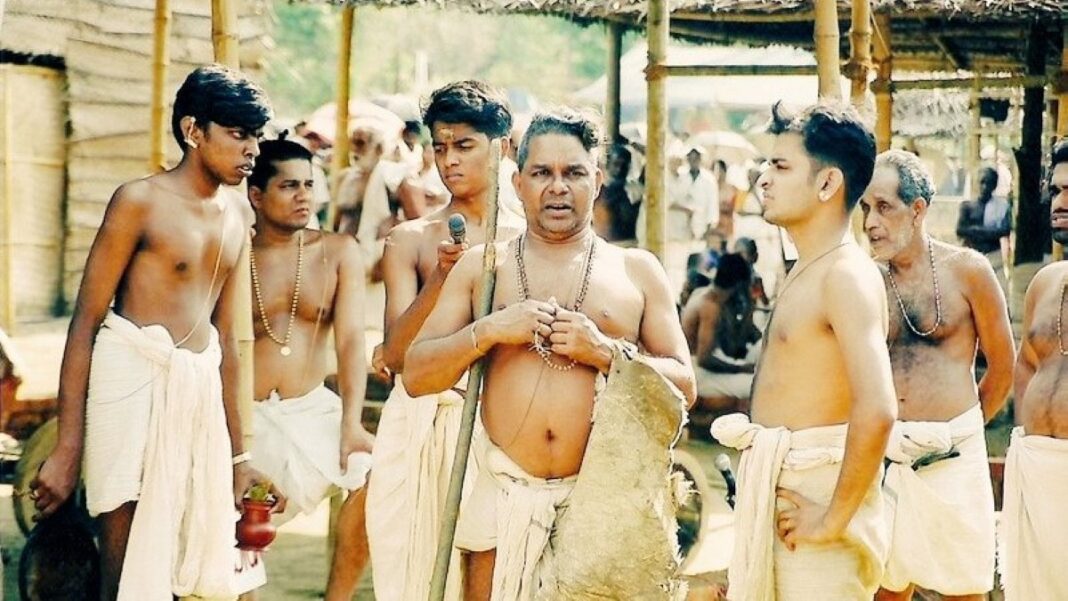INDIA: The Athirathram ritual, an ancient Vedic fire sacrifice that lasts 12 days, was held in Thrissur, Kerala, in 2011.
This rare and elaborate ritual drew scholars and spiritual seekers from all over the world, who gathered to witness the traditional ceremony that priests had not performed for over a century.
Hindus consider the Athirathram ritual one of the most significant Vedic rituals, with origins dating back over 3,000 years.
It is a complex and demanding ceremony that involves the construction of a Vedic altar, chanting sacred mantras, and offering various materials into the ritual fire.
The Varthathe Trust, a group dedicated to preserving Vedic traditions, organized the Athirathram ritual in Thrissur in 2011.
The Trust brought together a team of 121 Vedic scholars, priests, and assistants from various parts of India and worked tirelessly for months to prepare for the ceremony.
Sri. Somayaji, a well-known Vedic scholar and expert in the Athirathram ritual, performed the ceremony.
The Athirathram ritual began on April 4, 2011, with the construction of the Vedic altar, or Yajna Vedika.
The team built the ritual altar using various materials, including bricks, mud, and cow dung, and designed it according to precise Vedic specifications.
The altar was then consecrated with sacred water and adorned with flowers, fruits, and other offerings.
Over the next 11 days, the ritual continued with the sacred mantra chantings and offerings of various materials into the ritual fire.
The materials included clarified butter, grains, fruits, and vegetables.
The ritual also involved the performance of various yajnas, or sub-rituals, designed to invoke the blessings of various deities.
The Athirathram ritual concluded on April 15, 2011, with the final offering of the ritual fire.
Thousands of people, including spiritual seekers, scholars, and residents, attended the ritual.
The ceremony’s organizers hailed it as a great success, and many participants reported feeling a sense of peace and harmony after witnessing the ritual.
The Athirathram ritual is just one of many ancient Vedic rituals that Hindus still practice today.
These rituals are a significant part of Hindu culture and have many benefits, both spiritually and practically.
Hindus see the rituals as a way to connect with the divine, purify the environment, and promote peace and harmony among the living.
The significance of Vedic rituals in Hindu culture goes back thousands of years.
These rituals are rooted in the Vedas, the ancient texts that form the basis of Hinduism. They invoke the blessings of the gods and goddesses to promote harmony and balance in the universe.
One of the crucial elements of Vedic rituals is the offering of materials into the ritual fire.
According to Hindu beliefs, these offerings are a way of returning to the universe and promoting balance and harmony.
The materials offered to the fire vary depending on the ritual and the deity it invokes, but they often include fruits, flowers, grains, and clarified butter.
Another critical element of Vedic rituals is the chanting of sacred mantras. Mantras are transcending sounds or words that have a transformative effect on the mind and body. The mantras are often chanted in Sanskrit, the ancient language of India.
Scientific studies conducted during the Athirathram revealed that the traditional practice of organizing a yajnam has scientific benefits.
The Varthathe Trust, the organizers of the event, released the preliminary findings of the scientific committee responsible for conducting the studies.
The committee, headed by V. P. N. Nampoori, a Professor Emeritus at Cochin University of Science and Technology, told reporters that the studies found an accelerated growth in seed germination and a low microbial presence in water and soil during the yajnam.
The researchers discovered that seeds sown on the western side of the yajyasala germinated several times faster than those on the other sides.
Bengal gram, in particular, showed around a 2,000-fold faster growth rate than those on the other sides. Nampoori attributed this to the bio-amplifier generated in the atmosphere during the ritual.
The studies also found that the ritual positively impacted the atmosphere, reducing the presence of microbes in the area.
The team conducted microbial analyses at three locations in and around the yajyasala, with empirical results showing a decrease in the presence of microbes.
The researchers conducted microbial analyses before the commencement of the yajna, during the ritual, and for four days after its conclusion.
The study also analyzed the temperature’s dimension from the flames of the Pravagyam, the ritual fire, finding that the fireball had a particular wavelength with unusually high intensity, similar to what scientists observed in typical laser beams at about 3,870 degrees Celsius.
The committee members, including Rajalakshmy Subrahmanian from CUSAT, Parvathi Menon from MG College in Thiruvananthapuram, Maya R. Nair from Pattambi Government College, Prof. Saxena from the Indian Institute of Astrophysics in Bangalore, and Prof. Rao from Andhra University, all contributed to the research.
During a press conference, Varthathe Trust members Sivakaran Namboodiri and Madhu Kuttat expressed their satisfaction with the findings, stating that they hoped the scientific explanation would encourage more people to participate in the yajnam. The team published its discoveries in the CSIR’s Indian Journal of Traditional Medicine.
Overall, the preliminary findings suggest that the traditional practice of conducting a yajnam has scientific benefits that could impact agriculture, the environment, and human health. With further investigations, this research could lead to discoveries and innovations in traditional medicine.
Also Read: 14 Hindu Temples in Northeastern Bangladesh Damaged by Miscreants, Police Launch Probe



